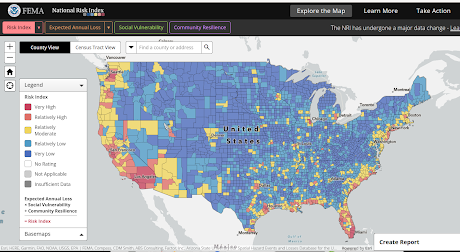
FEMA National Risk Index For Natural Disasters
#17,838
As the FEMA map at the top of this blog indicates, I live in a `disaster prone' region of the United States (West-Central Florida). When it comes to natural disasters California and Florida lead the nation.
But increasingly, fires, floods, tornadoes, earthquakes and other major disruptions have severely impacted just about everywhere in the nation.
While it doesn't take a billion dollar disaster to put you, or your loved ones at risk, they do speak to the frequency of large-scale weather and climate disasters Americans face each year. In 2023, there were at least 25 such events.
Add in thousand of house fires, hundreds of tornadoes, lesser floods and wild fires, and tens of thousands of other smaller emergencies, and there are plenty of reasons to be prepared for the unexpected.
Having grown up in Hurricane country, spending 15 of those years living aboard (3) different boats, and having worked as paramedic/EMT in 3 different coastal counties, I'm probably a bit more sensitized to the need for preparedness than most.
I take it seriously, and over the years, my penchant for being prepared has been invaluable more than once. Even though I'm probably better prepared than 90% of the population, I continue to improve my ability to deal with the unexpected each year.
This year, I made several upgrades to my solar power preps (see My Upgraded Solar Power System (2023 Edition), I've substantially increased my water storage (now 90 gals), and have added USB battery powered water pumps and have upgraded my propane storage for emergency heat/cooking.
Five years ago, in NIAC: Surviving A Catastrophic Power Outage, we looked at a NIAC (National Infrastructure Advisory Council) 94-page report that examines the United State's ability to respond to and recover from a widespread catastrophic power outage.
Each year FEMA conducts a nationwide poll on preparedness, and they released their 2023 survey earlier this month. Even though these are self-reported assessments, and `being prepared' means different things to different people, they report some small progress over the past 12 months.
It is a mixed bag, however. More people have assembled supplies, but fewer people report practicing emergency drills or habits. More have learned their evacuation routes, but fewer have made a plan. And while more have tested a family communication plan, fewer report having signed up for alerts or warnings.
While everyone's needs and circumstances are different, and there is no way to know (with certainty) what challenges lie ahead in 2024, there are some basic goals one should strive for.
So . . . if a disaster struck your region today, and the power went out, stores closed their doors, and water stopped flowing from your kitchen tap for the next 7 to 14 days . . . you are you ready with:
- A battery operated NWS Emergency Radio to find out what was going on, and to get vital instructions from emergency officials
- A decent first-aid kit, so that you can treat injuries
- Enough non-perishable food and water on hand to feed and hydrate your family (including pets) for the duration
- A way to provide light when the grid is down.
- A way to cook safely without electricity
- A way to purify or filter water
- A way to handle basic sanitation and waste disposal.
- A way to stay cool (fans) or warm when the power is out.
- A small supply of cash to use in case credit/debit machines are not working
- An emergency plan, including meeting places, emergency out-of-state contact numbers, a disaster buddy, and in case you must evacuate, a bug-out bag
- Spare supply of essential prescription medicines that you or your family may need
- A way to entertain yourself, or your kids, during a prolonged blackout


